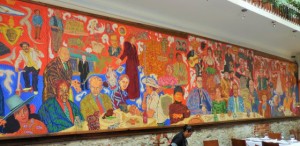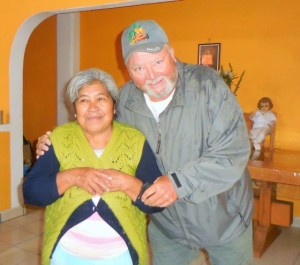
March 13, 2015 – We arrived in Mexico City on schedule on March 10 and I will talk about our fabulous experience and meeting old and new friends on the next Blog. A strong internet signal remains elusive at these RV Parks so I find myself catching up on our travels.
Oaxaca
Our journey from the Pacific to Oaxaca was quite a journey, although not great in distance it was very challenging as we had to ascend 8000 ft (2700 m) and hundreds of switchbacks, it took us 10 hours for 150 miles (250 km), but we did make it finally. Day 1 saw us get Bruce & Marian’s tire repaired, an oil change for us, our laundry dropped off and our Propane Bottles filled. After lunch we headed into El Tule to see the World’s Largest Tree, over 2000 years old. It was big, huge actually, a cypress. Amazing it has lasted this long. After a walkabout the shops and the Zocalo we headed off for groceries at Walmart. We got off the beaten path into endless one way streets in burbs and eventually did find our way, Mike and Kelly who were following went to another Walmart and we all successfully made it back to the campground.
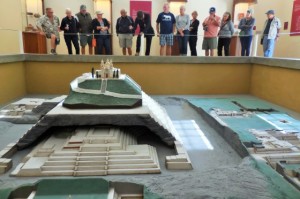
The next day we drove into Oaxaca, found parking and tourist office and the made arrangements for City Bus Tour, it was little over an hour, inexpensive, $70 pesos each. This was lots of fun, and when it started to rain it was good we had a roof. Later as we returned to the Van Lisa purchased a beautiful Wall Hanging, this will look beautiful in our house. Shortly after returning to the campground the Amigos Rodante RV Caravan arrived, 13 RVs which had intended to be in Oaxaca earlier but had been delayed by protests to South. This was the first time I had met Pierre Blais and his wife Louise, very nice folks who had been leading tours in Mexico for 31 years.
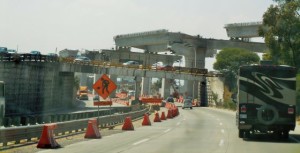
Day 3 and we returned to historic downtown of Oaxaca, what a wonderful place to spend some time. This time we parked closer to markets De Artesanias 20 de Noviembre and Benito Juarez. Shopping was exhausting and we would return to Benito Juarez. Lisa had a lovely lunch on Zocalo, a little expensive but worth every penny (pesos). We gathered everyone up and back to the campground, but not before we stopped to make reservations locally for dinner. After returning we had a surprise Birthday Happy Hour for Bruce, this was fun and he was surprised.
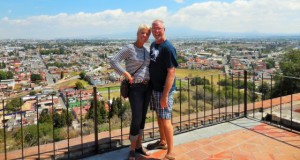
Day 4 we returned once again to Oaxaca and also the markets, Lisa and I also took in the Benito Jaurez Museo. We had lunch locally and tasted some local recipes, always interesting, later that evening we all had dinner down the road from the campground, great service. The entire complex had a FONATOUR feel to it. A tourist venture without any tourists.
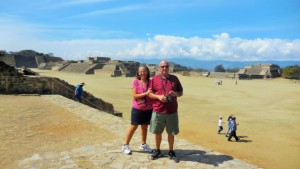
Saturday morning we were off to the Zapotec city of Monte Alban, a large pre-Columbian archaeological site southwest of the city of Oaxaca established around 500 BC and abandoned before 800AD. The site is located on a low mountainous range rising above the plain in the central section of the Valley of Oaxaca. The site is very impressive and we could climb the largest structures, I got a real workout for sure. We stopped at a grocery store on our return to the campground for a couple of items. Later I managed a short siesta, a equally short Happy Hour with Chocolate Cake courtesy of Bruce & Marian. After dinner Lisa and I watched more of Deadwood (HBO Series).
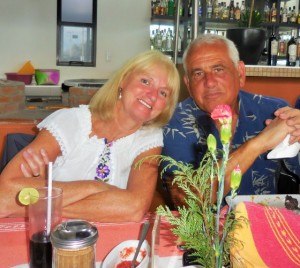
Puebla
After 6 days in Oaxaca we were off to Puebla lead by Roland and Janice, fortunately it was a Sunday. Traffic not too busy and quota road great on the north side of town. Not much to report than beautiful vistas and panoramic views as we as we drove across the mountains. Raefael and Eileen did have some shifting issues with their transmission, not a transmission failure as such, more likely some internal solenoid problems. Grant had a can on transmission magic fluid which seemed to help. We made it to our campground in Cholula (a suburb of Puebla) about 3 pm without any missteps or wrong turns, even with all the road construction coming into town. After set up we called a meeting to review our remaining schedule and make some adjustments, hard to believe we are on the last third of our 90 Day Mexican Adventure. Later a number of us went out in search of dinner, we stumbled upon a Family Day Celebration in the Cholula Zocalo and a little hole in the wall restaurant. One more episode of Deadwood and we were asleep.
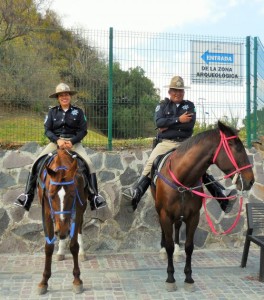
Rafael and Eileen were keen to have their transmission looked at. In the end it had to be replaced. They stayed with Grant & Anita for a couple of nights but had it replaced in time to leave with the rest of us and as a bonus at a very reasonable price. We had pre-arranged a guide for Puebla, a good friend of Antonio Resendiz from Bahia de Los Angeles on Baja, Carlos. Carlos brought along Alberto, a real expert in pre-Columbian and Colonial history. They provided us with a terrific two days of touring in both Puebla and Cholula next door. We saw some fabulous churches in both towns and the largest pyramid in the western hemisphere, we even got to go inside it, fabulous.

Tuesday night the heavy rain started and it continued almost all day as we drove with Carlos to Contla, about an hour away. We had promised Afrain from Baja (Blanket Factory) that we would visit his family home where they produce all the good we see in his shop. We did not know what to expect and when we arrived we were welcomed with the hospitality we have enjoyed from so many Mexicans across the country over so many years. After initial introductions we were treated to some local refreshments and fresh baked goods. Then we headed across the street to see where everything was made. Some of the looms were fairly modern, others pre-dated the depression. It was a real treat to see all this in action, we learned that all the product is delivered to Baja by ruck across on the ferry from Mazatlan. Next we returned and a shopping spree broke out, no negotiation required, the prices were just that good. Following all the purchasing we sat down for lunch, prepared by Afrain’s Mom and Sisters, then Tres Leches Cake for desert. Mexican’s are wonderful people and this experience made our trip extra special indeed.
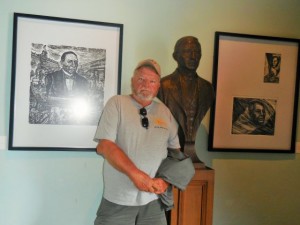
We returned to Cholula and headed out to Carlos and Cotty’s house for a pre-arranged dinner at 6 pm. Again the hospitality was amazing as was the food. They had prepared all locally made traditional Puebla dishes front beginning to end, I lost count of how many courses. We also met their daughter, Alejandra and her baby daughter. The gals got the nana and gramma fix in for sure. What a fabulous end to our Puebla stay, we will be back again for sure. Big thanks to Carlos and Cotty for making our visit so wonderful.
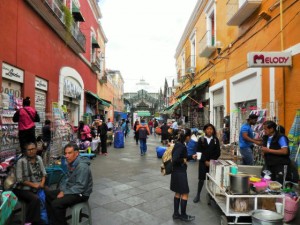
Did you know?
The Pico de Orizaba or Citlaltépetl (Nahuatl: {citlal} star, and {tepētl} mountain), is a stratovolcano, the highest mountain in Mexico and the third highest in North America, after Denali (formerly known as Mount McKinley) of the United States and Mount Logan of Canada. It rises 5,636 metres (18,491 ft) above sea level in the eastern end of the Trans-Mexican Volcanic Belt, on the border between the states of Veracruz and Puebla. The volcano is currently dormant but not extinct, with the last eruption taking place during the 19th century. It is the second most prominent volcanic peak in the world after Africa’s Mount Kilimanjaro.

Toponymy
The Pico overlooks the valley and city of Orizaba, from which it gets its name. The name Citlaltépetl is not used by Nahuatl speakers of the Orizaba area, who instead call it Istaktepetl (Iztactépetl in the traditional orthography for Classical Nahuatl), or ‘White Mountain’. In the earliest mention of the volcano, it was referred to by the natives during the Pre-Columbian Era as Poyautécatl, which means “the ground that reaches the clouds”. Citlaltépetl was the common name in the Náhuatl language when the Spanish arrived in Mexico. Citlaltépetl comes from the Náhuatl citlalli (star) and tepētl (mountain) and thus means “Star Mountain”. This name is thought to be based on the fact that the snow-covered peak can be seen year round for hundreds of kilometers throughout the region. A legend from the city of Coscomatepec tells of how the planet Venus can be seen settling into the crater of Citlaltépetl. During the colonial era, the volcano was also known as Cerro de San Andrés due to the nearby settlement of San Andrés Chalchicomula at its base. A third name, Poyauhtecatl, which means “the one that colors or illuminates”, has also been recorded. This name was given by the Tlaxcaltecas in memory of their lost country.
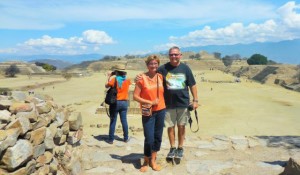
Topography
The peak of Citlaltépetl rises dramatically from the shores of the Gulf of Mexico to an elevation of 5,636 m (18,491 ft) above sea level; it has a topographic prominence of 4,922 m (16,148 ft). Regionally dominant, Pico de Orizaba is the highest peak in Mexico and the highest volcano in North America; it is also the third highest peak in North America after Denali and Mount Logan. Orizaba is ranked 7th in the world in topographic prominence. It is the second most prominent volcanic peak in the world after Africa’s Mount Kilimanjaro, and the volcano is also ranked 16th in the world for topographic isolation. About 110 km (68 mi) to the west of the port of Veracruz, its peak is visible to ships approaching the port in the Gulf of Mexico, and at dawn rays of sunlight strike the Pico while Veracruz still lies in shadow. The topography of Pico de Orizaba is asymmetrical from the center of the crater; the eastern face is the steepest side of the volcano and the northwestern face the most gradual side. The gradual slopes of the northwestern face of the volcano allows for the presence of large glaciers and is the most traveled route to take for hikers traveling to the summit.
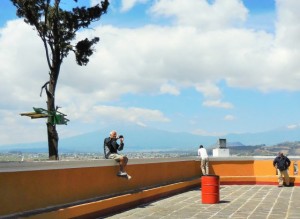
Glaciers
Pico de Orizaba is one of only three volcanoes in México that continue to support glaciers and is home to the largest glacier in Mexico, Gran Glaciar Norte. Orizaba has nine known glaciers: Gran Glaciar Norte, Lengua del Chichimeco, Jamapa, Toro, Glaciar de la Barba, Noroccidental, Occidental, Suroccidental, and Oriental. The equilibrium line altitude (ELA) is not known for Orizaba. Snow on the south and southeast sides of the volcano melts quickly because of solar radiation, but lower temperatures on the northwest and north sides allow for glaciers. The insolation angle and wind re-deposition on the northwest and north sides allow for constant accumulation of snow providing a source for the outlet glaciers. On the north side of Orizaba, the Gran Glaciar Norte fills the elongated highland basin and is the source for seven outlet glaciers. The main glacier extends 3.5 km (2.2 mi) north of the crater rim, has a surface area of about 9.08 km2(3.51 sq mi) descending from 5,650 m (18,540 ft) to about 5,000 m (16,000 ft). It has a slightly irregular and stepped profile that is caused in part by the configuration of the bedrock. Most crevasses show an ice thickness of approximately 50 m (160 ft).
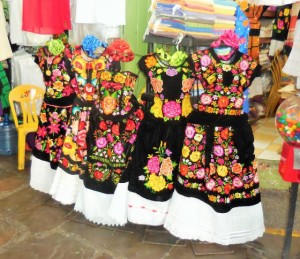
Below the 5,000 m (16,000 ft) in elevation on the north side of the volcano, the outlet glaciers Lengua del Chichimeco and Jamapa extend north and northwest another 1.5 km (0.93 mi) and 2 km (1.2 mi), respectively. The terminal lobe of Lengua del Chichimeco at 4,740 m (15,550 ft), having a gradient of only 140 m km−1 (26.5 ft/mi), is a low, broad ice fan that has a convex-upward profile, a front typical of almost all Mexican glaciers. The most distinct glacier is Glaciar de Jamapa, which leaves Gran Glaciar Norte at about 4,975 m (16,322 ft) and, after 2 km (1.2 mi) with a gradient of 145 m km− 1 (27.5 ft/mi), divides into two small tongues that end at 4,650 m (15,260 ft) and 4,640 m (15,220 ft). Both tongues terminate in broad convex-upward ice fans thinning along their edges. The retreat of these tongues prior to 1994 produced much erosion downstream and buried their edges by ablation rock debris.

The west side of Gran Glaciar Norte generates five outlet glaciers. From north to south, the first two, Glaciar del Toro and Glaciar dela Barba, are hanging cliff or icefall glaciers, reaching the tops of giant lava steps at 4,930 m (16,170 ft) and 5,090 m (16,700 ft), respectively. They then descend 200 to 300 m (660 to 980 ft) farther down into the heads of stream valleys as huge ice blocks but are not regenerated there. About 1 km (0.62 mi), Glaciar Noroccidental, a small outlet glacier 300 m (980 ft) long, drains away from the side of Gran Glaciar Norte at about 5,100 m (16,700 ft) and draws down the ice surface a few tens of meters over a distance of 500 m (1,600 ft), descending to 4,920 m (16,140 ft) with a gradient of 255 m km− 1 (48.3 ft/mi). Another 1 km (0.62 mi) still farther south, Glaciar Occidental breaks away from Gran Glaciar Norte west of the summit crater at about 5,175 m (16,978 ft) as a steep, 1 km (0.62 mi) long glacier having a gradient of 270 m km− 1 (51.1 ft/mi) that ends at 4,930 m (16,170 ft). From the southwest corner of the mountain, another outlet glacier, Glaciar Suroccidental, 1.6 km (0.99 mi) long, flows from Gran Glaciar Norte at 5,250 m (17,220 ft) with a gradient of 200 m km− 1 (37.8 ft/mi), which also ends at 4,930 m (16,170 ft) in a long smooth surface.
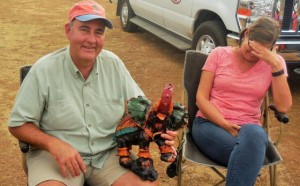
East of the summit cone, a separate steep niche glacier, Glaciar Oriental, 1.2 km (0.75 mi) long and having a gradient of 440 m km− 1 (83.3 ft/mi), flows down the mountainside from about 5,600 to 5,070 m (18,370 to 16,630 ft); it contains many crevasses and seracs and is the most difficult glacier to climb. Glacier Oriental had a surface area of about 420,000 m2 (4,500,000 sq ft) in 1958, which makes the total area of glaciers and firm field on Citlaltépetl about 9.5 km2 (3.7 sq mi). No earlier historical record of glacier tongue activity (advance or recession) is known for Citlaltépetl’s glaciers. Although the Gran Glaciar Norte ice cap is covered with snow, it is possible to see the seven outlet glaciers on the irregular west margin of the ice cap, especially Glaciar de Jamapa and Glaciar Occidental.

Climate
The climate of Pico de Orizaba, like the Sierra Madre Oriental, varies greatly due to the change of elevation and prevailing winds. Due to the latitude and the extreme rugged terrain the volcano experiences many microclimates. Vegetation varies from tropical at the lower elevations on the eastern face to alpine forests in the higher elevations. Large amounts of precipitation fall on the eastern face of the volcano due to adiabatic cooling and condensation from the trade winds that bring moisture off the Gulf of Mexico. The eastern face is frequently covered by fog and low cloud cover. The climate of the eastern face varies from tropical (Af) at the lower elevations to subtropical highland (Cwb) at the higher elevations, with mild variation in temperatures and an average annual rainfall of 1,600 mm (63 in).

Subtropical climates are found between 2,200–3,200 m (7,200–10,500 ft) above sea level with a regular rainfall all year long. Autumn and winter come with frequent freezes and light snow, but the snow on the south and southeast sides melt quickly due to solar radiation. The northern face is dominated by subtropical highland (Cwb). The southern face mostly experiences humid subtropical climate Cfa which experiences the highest annual temperatures in the month of April.

Due to katabatic winds the western side is dominated by steppe (BSk) creating a rain shadow below 2,600 m (8,500 ft) above sea level. Although there are some areas on the western side that experience (Cfa) most of the area is semi-dry with temperate to warm temperatures and an annual precipitation average of 550 mm (22 in). Vegetation that is mainly observed here is grass and shrubs with few alpine species.

Between 3,200–4,300 m (10,500–14,100 ft) where temperatures usually are between 2 to 5 °C (36 to 41 °F), continental subarctic climate (Dfc) predominates. Over 4,300 m (14,100 ft) with an annual average low of −2 °C (28 °F), alpine tundra (ET) prevails to the summit; heavy snowfalls and blizzards are common throughout the year. Snow on the south and southeast melts due to solar radiation, but continually remains on the north and northwestern faces. Extreme cold dominates a surface area of approximately 31 km2 (12 sq mi).
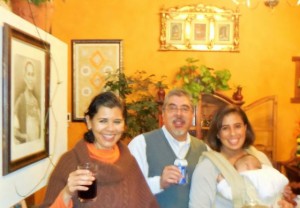
Geology
Pico de Orizaba evolved in three stages, the most recent initiating about 16,000 years ago during the late Pleistocene and Holocene. Citlaltépetl consists of three superimposed stratovolcanoes and dome intrusions which are: Torrecillas (650–250 ka), Espolón de Oro (210– 16 ka), and Citlaltépetl (16 ka to present). The volcano was formed by thick andesitic and dacitic lavas that followed repetitive explosive eruptions and lava effusions which created the iconic cone structure. The volcano is currently dormant but not extinct. The latest eruption of the volcano occurred in 1846 with a magnitude of VEI 2. Previous eruptions occurred in: 1687, 1613, 1589–1569, 1566, 1555–1545,1539–1533, 1351, 1260, 1187, 1175, 1157, 220 AD, 140 AD, 90 AD, 40 AD, ~780 BC, ~1500 BC, ~2110 BC, ~2300, ~2500, ~2780, ~4690, ~6220, ~6710, ~7030, and ~7530. The most violent eruption in the volcano’s history is thought to have occurred around 6710 BC reaching a magnitude of VEI 5 characterized by lava dome extrusion and pyroclastic flow.
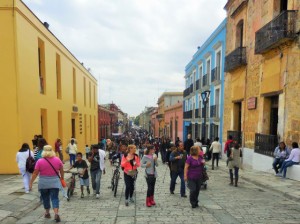
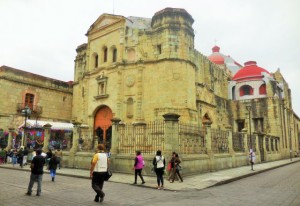
The volcano’s crater is elliptical with a transverse diameter measuring 478 m (1,568 ft) and a conjugate diameter measuring 410 m (1,350 ft). The crater has an estimated 154,830 m2 (1,666,600 sq ft) with a maximum depth of 300 m (980 ft). Pico de Orizaba is constantly covered by an ice cap consisting of several glaciers. An outlet glacier, known as Jamapa Glacier is located on the northeastern side of the peak; it has been a powerful force in shaping the volcano. The Jamapa Glacier is responsible for a significant portion of the geomorphologic evolution of the region surrounding the volcano.
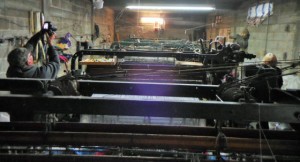
Geography
Pico de Orizaba is located at 19°1′48″N 97°16′12″W at a distance of 100 km (62 mi) from the shores of the Gulf of Mexico. Orizaba is located 200 km (120 mi) east of Mexico City lies on the border between the states of Veracruz and Puebla. The volcano is approximately 480 km (300 mi) south of the Tropic of Cancer. Orizaba is found at the southeastern end of the Trans-Mexican Volcanic Belt, a volcanic chain that runs from west to east across Central Mexico; it is the only historically active volcano in the area. A companion peak lying about six km to the southwest of Pico de Orizaba is the Sierra Negra, at 4,640 m (15,223 ft). This subsidiary peak is significantly lower than its massive neighbor, but is traversed by the highest road in North America passing over its summit.
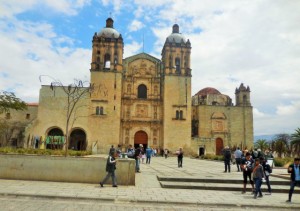
Pico de Orizaba, like the Sierra Madre Oriental, forms a barrier between the coastal plains of the Gulf of Mexico and the Mexican Plateau. The volcano blocks the moisture from the Gulf of Mexico from saturating central Mexico and influences the climates of both areas. Both the state of Veracruz and Puebla depend on Pico de Orizaba for supplying fresh water. The largest river originating on the volcano is the Jamapa River.
History
Pico de Orizaba was important in pre-Hispanic cultures, such as those of the Nahuatl-speaking Aztecs and the Totonacs. The volcano is part of many native mythologies. In ancient Olmec mythology, Orizaba was an eagle spirit that formed the volcano. The Olmec believed that they were to hike and pray to the god at the zenith of the volcano on a continuous basis to prevent the god from getting upset and erupting in fury. During the Spanish Conquest of Mexico, Hernán Cortés passed through the foothills of Pico de Orizaba; the volcano and the surrounding mountains made his journey to Tenochtitlan more difficult and delayed him for many days. During the 1600s, the Spanish Crown financed several roads to be built that would circumvent Citlaltépetl.
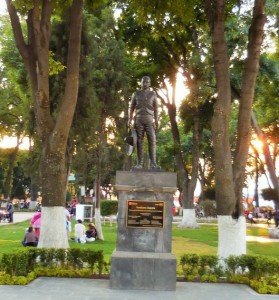
One of the roads was routed south of the volcano through the cities of Orizaba and Fortín de las Flores, which became the main trade route between Mexico City and Veracruz on the Gulf Coast. A short road was later built by Jesuits to establish settlements at the base of Pico de Orizaba. The Spanish used the volcano as a landmark to guide themselves to the port of Veracruz. Many battles were fought near this volcano throughout Mexico’s struggle for independence.

In 1839, Henri Galeotti was the first European to explore the volcano, but did not hike to the summit. During the American occupation of Mexico in 1848, two American soldiers, F. Maynard and William F. Raynolds, were the first known hikers to reach the summit of Pico de Orizaba. Later that year the French explorer, Alejandro Doignon also reached the summit. During the mid-19th century Citlaltépetl was explored by many scientists, of which the most famous was the German botanist, Hugo Fink; he was the first to record the numerous species of flora found on the volcano. In 1873, Martin Tritschler raised the Mexican flag at the summit. On December 16, 1936, President Lázaro Cárdenas, in an effort to protect the natural beauty of Pico de Orizaba, created a national park with an area of 19,750 hectares (48,800 acres) which included the volcano with the surrounding area and the settlements of Tlachichuca, Ciudad Serdán, La Perla, Mariano Escobedo, and Calcahualco. The federal decree became federal law on January 4, 1937.

Climbing and recreation
El Pico de Orizaba attracts a large number of international climbers every year. There are many routes for approaching and climbing the volcano, and many people attempt it, mostly during the period from October to March. The most frequented route begins from the base camp Piedra Grande Hut (“refugio”) via the Jamapa Glacier. Piedra Grande Hut Base Camp is located at an elevation of 4,270 m (14,010 ft) above sea level; it is a great place to stay or acclimatize to the high altitude. Another option as a starting point is high camp located at the base of the glacier about 4,900 m (16,100 ft) above sea level. For a more technical challenge for the experienced climber, there is a technical ice climb called the Serpents Head which involves 10 pitches of grade 3 ice. Additionally, the southern side offers another challenging option; although the trail is shorter, it is also steeper and more difficult. No glaciers are found on the southern side. The final ascent to the summit is via a normally straightforward and un-crevassed glacier route. The caldera can be circumnavigated with relative ease, although at one point this requires a short, exposed traverse of steep rock and ice above the Glacier Este.
